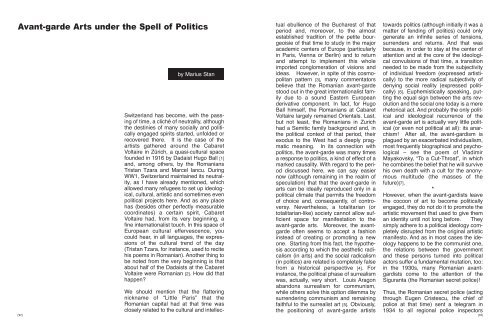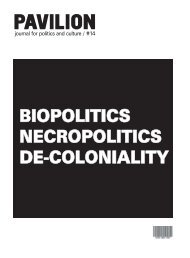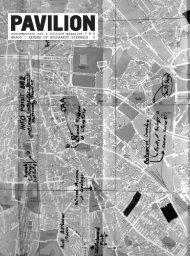Download pdf version of issue no. 16 (4 Mb) - Pavilion
Download pdf version of issue no. 16 (4 Mb) - Pavilion
Download pdf version of issue no. 16 (4 Mb) - Pavilion
Create successful ePaper yourself
Turn your PDF publications into a flip-book with our unique Google optimized e-Paper software.
Avant-garde Arts under the Spell <strong>of</strong> Politics<br />
[92]<br />
by Marius Stan<br />
Switzerland has become, with the passing<br />
<strong>of</strong> time, a cliché <strong>of</strong> neutrality, although<br />
the destinies <strong>of</strong> many socially and politically<br />
engaged spirits started, unfolded or<br />
recovered there. It is the case <strong>of</strong> the<br />
artists gathered around the Cabaret<br />
Voltaire in Zürich, a quasi-cultural space<br />
founded in 19<strong>16</strong> by Dadaist Hugo Ball [1]<br />
and, among others, by the Romanians<br />
Tristan Tzara and Marcel Iancu. During<br />
WW1, Switzerland maintained its neutrality,<br />
as I have already mentioned, which<br />
allowed many refugees to set up ideological,<br />
cultural, artistic and sometimes even<br />
political projects here. And as any place<br />
has (besides other perfectly measurable<br />
coordinates) a certain spirit, Cabaret<br />
Voltaire had, from its very beginning, a<br />
fine internationalist touch. In this space <strong>of</strong><br />
European cultural effervescence, you<br />
could hear, in all languages, the expressions<br />
<strong>of</strong> the cultural trend <strong>of</strong> the day<br />
(Tristan Tzara, for instance, used to recite<br />
his poems in Romanian). A<strong>no</strong>ther thing to<br />
be <strong>no</strong>ted from the very beginning is that<br />
about half <strong>of</strong> the Dadaists at the Cabaret<br />
Voltaire were Romanian [2]. How did that<br />
happen?<br />
We should mention that the flattering<br />
nickname <strong>of</strong> “Little Paris” that the<br />
Romanian capital had at that time was<br />
closely related to the cultural and intellec-<br />
tual ebullience <strong>of</strong> the Bucharest <strong>of</strong> that<br />
period and, moreover, to the almost<br />
established tradition <strong>of</strong> the petite bourgeoisie<br />
<strong>of</strong> that time to study in the major<br />
academic centers <strong>of</strong> Europe (particularly<br />
in Paris, Vienna or Berlin) and to return<br />
and attempt to implement this whole<br />
imported conglomeration <strong>of</strong> visions and<br />
ideas. However, in spite <strong>of</strong> this cosmopolitan<br />
pattern [3], many commentators<br />
believe that the Romanian avant-garde<br />
stood out in the great internationalist family<br />
due to a sound Eastern European<br />
derivative component. In fact, for Hugo<br />
Ball himself, the Romanians at Cabaret<br />
Voltaire largely remained Orientals. Last,<br />
but <strong>no</strong>t least, the Romanians in Zurich<br />
had a Semitic family background and, in<br />
the political context <strong>of</strong> that period, their<br />
exodus to the West had a deeply pragmatic<br />
meaning. In its connection with<br />
politics, the avant-garde was many times<br />
a response to politics, a kind <strong>of</strong> effect <strong>of</strong> a<br />
marked causality. With regard to the period<br />
discussed here, we can say easier<br />
<strong>no</strong>w (although remaining in the realm <strong>of</strong><br />
speculation) that that the avant-garde in<br />
arts can be ideally reproduced only in a<br />
political climate that permits the freedom<br />
<strong>of</strong> choice and, consequently, <strong>of</strong> controversy.<br />
Nevertheless, a totalitarian (or<br />
totalitarian-like) society can<strong>no</strong>t allow sufficient<br />
space for manifestation to the<br />
avant-garde arts. Moreover, the avantgarde<br />
<strong>of</strong>ten seems to accept a fashion<br />
instead <strong>of</strong> creating or promoting a new<br />
one. Starting from this fact, the hypothesis<br />
according to which the aesthetic radicalism<br />
(in arts) and the social radicalism<br />
(in politics) are related is completely false<br />
from a historical perspective [4]. For<br />
instance, the political phase <strong>of</strong> surrealism<br />
was, actually, very short. Louis Aragon<br />
abandons surrealism for communism,<br />
while others solve this option dilemma by<br />
surrendering communism and remaining<br />
faithful to the surrealist art [5]. Obviously,<br />
the positioning <strong>of</strong> avant-garde artists<br />
towards politics (although initially it was a<br />
matter <strong>of</strong> fending <strong>of</strong>f politics) could only<br />
generate an infinite series <strong>of</strong> tensions,<br />
surrenders and returns. And that was<br />
because, in order to stay at the center <strong>of</strong><br />
attention and at the core <strong>of</strong> the ideological<br />
convulsions <strong>of</strong> that time, a transition<br />
needed to be made from the subjectivity<br />
<strong>of</strong> individual freedom (expressed artistically)<br />
to the more radical subjectivity <strong>of</strong><br />
denying social reality (expressed politically)<br />
[6]. Euphemistically speaking, putting<br />
the equal sign between the arts revolution<br />
and the social one today is a mere<br />
rhetorical act. And probably the only political<br />
and ideological recurrence <strong>of</strong> the<br />
avant-garde art is actually very little political<br />
(or even <strong>no</strong>t political at all): its anarchism!<br />
After all, the avant-gardism is<br />
plagued by an exacerbated individualism,<br />
most frequently biographical and psychological<br />
– see the poem <strong>of</strong> Vladimir<br />
Mayakovsky, “To a Cut-Throat”, in which<br />
he combines the belief that he will survive<br />
his own death with a cult for the a<strong>no</strong>nymous<br />
multitude (the masses <strong>of</strong> the<br />
future)[7].<br />
*<br />
However, when the avant-gardists leave<br />
the cocoon <strong>of</strong> art to become politically<br />
engaged, they do <strong>no</strong>t do it to promote the<br />
artistic movement that used to give them<br />
an identity until <strong>no</strong>t long before. They<br />
simply adhere to a political ideology completely<br />
disrupted from the original artistic<br />
manifesto. And as in most cases the ideology<br />
happens to be the communist one,<br />
the relations between the government<br />
and these persons turned into political<br />
actors suffer a fundamental mutation, too:<br />
in the 1930s, many Romanian avantgardists<br />
come to the attention <strong>of</strong> the<br />
Siguranta (the Romanian secret police)!<br />
Thus, the Romanian secret police (acting<br />
through Eugen Cristescu, the chief <strong>of</strong><br />
police at that time) sent a telegram in<br />
1934 to all regional police inspectors<br />
[93]








